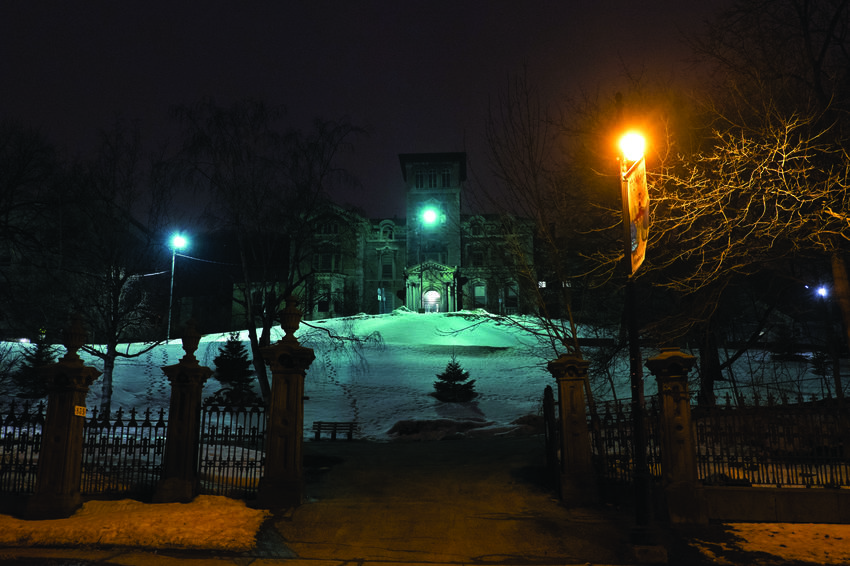From the Upper Rez residents complaining about the hill to the hotel-style residents’ habit of locking themselves out, each McGill residence has its own atmosphere and annoyances. One of the few things they share in common are the urban legends that any first-year student living in residence has heard. These widely shared myths—be it a cautionary tale told by floor fellows during the first floor meeting of the year, or simply the spread of a good story—keep residents on their toes while also teaching a lesson or two.
New Rez Fire: Candle in the wind, the curtain, and, well, everything else
One commonly heard story among students who lived in Rez is that of a first year girl who forgets to blow out a candle in her room before leaving. The candle lights her curtains on fire, setting off the sprinklers and flooding three floors, after which she supposedly drops out of McGill, never to be seen again.
“The way I heard it was from my floor fellow,” said Alex Levesque, U3 Science and a floor fellow at New Rez. “[As the story goes], she had a single room, and her boyfriend would come over a lot. One time, […] they decided to light a candle to set the mood, and [it lit up] the curtain, which instantly set the sprinklers off.”
It’s a story oft-repeated, and for good measure, too: According to Levesque, first-years frequently tend to set off the sprinklers. With no real fire, sprinkler systems can cause extensive damage to property.
“[Supposedly] it soaked through her room, and probably two or three floors,” Levesque said. “That caused […] $200,000 in [damages], but they said she did drop out […] partially because of the money, but [also] because people were rude to her after that.”
This story is alarming, indeed. The cautionary tale is used by all floor fellows, but actual details differ from residence to residence, raising questions about its validity. Alison Gu, U2 Science student and floor fellow at Douglas Hall, remembers the story quite differently from Levesque.
“From what I understand, […] she was taking a bath, [so] she lit a candle. [It] was not in her bathroom so she didn’t realize, and it caught everything on fire. [….] She had to pay for the damages, and was in debt for $300,000 [and] had to drop out of McGill,” said Gu.
To residence leadership, the story’s level of merit isn’t important; rather, their goal with this story is to prevent first years from accidentally activating the sprinkler system. It’s also an attempt to discourage students from intentionally setting off the fire alarm, although judging by the amount of times the alarm has gone off in New Rez this past month—five in total, and twice in one night—perhaps a scarier urban legend might just do the trick.
Hell’s Angels: Weeding out the competition
As if the story of Candle Girl wasn’t terrifying enough, another urban legend from Rez involves the Hell’s Angels. The quintessential story that floor fellows tell to dissuade people from selling drugs in residence, is one that has sent shivers down the backs of new students for years.
“The way my floor fellow [told the story] was there was this drug dealer in Gardner [who] kept coming home to find pictures of himself taped to his door, and then one day he came in [to] find [members] of Hell’s Angels sitting in his room, and his furniture […] slashed with [knives]. They threatened him [to get him] to stop [selling drugs on their turf],” Levesque said.
The story varies with different degrees of extremity depending on the person telling it. Levesque also recounted another version he heard in which the student was dangled by his feet from the window by Hell’s Angels, although Levesque admitted this version of the tale is probably ridiculous.
There is another version of the legend in which pictures of the student were taped to his window—a more intrusive detail than his door. Another describes how the Angels posted personal pictures of the student on his Facebook wall. Nevertheless, whatever version of the tale, the moral is to avoid selling drugs in McGill residences.
Douglas Hall: The haunted house on the hill
Douglas Hall is known to be McGill’s most haunted residence, simply because of its age and architectural style. Built in 1937 during the Great Depression era, Douglas Hall, with its ancient cobblestone structure, resembles that of a Victorian mansion out of a horror film. It comes as no surprise that this residence comes with a few stories—some likely invented by floor fellows to scare first years, while others perhaps containing a grain of truth.
One such story is the existence of a ghost living within the walls of Douglas Hall. Although its origins are unknown, its presence can be felt throughout.
“My floor fellow in my first year […] fully believed that there was a […] ghost, but it was apparently friendly,” Gu said. “There was somebody who had a plant, and they put the plant outside to get some sunlight and it disappeared. He thought somebody had stolen it and he made a post [on Facebook] about it. [Eight months later] he found it in the basement somewhere, and it was dead. People were like, ‘Oh, the Douglas ghost!’”
While the presence of this ghost in Douglas is up for debate, the story likely originated in the general spooked feeling that residents have while walking through the building’s old halls.
“[The ghost rumours are] probably because [Douglas was] built so long ago and seems to have more character […] than the other residences, and it can be really creepy at night,” Gu explained. “I don’t know what it is, but it is just spooky.”
If one does believe in the legend of the ghost of Douglas Hall, there’s no reason to worry. It seems to be relatively friendly, despite occasionally stealing students’ plants.








